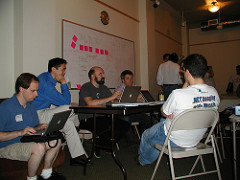Developer meeting braindump
Often after one of our Western Mass. Developer Group meetings I want to make a list of things we talked about. This time I actually did it. This only includes stuff I talked about or was within earshot of – minus the top secret material that you can only know about if you show up in person.
- C# structures and their fans and detractors
- BASIC Computer Games, the book
- the Amiga and “guru meditation”. Amiga’s not dead! Again, yet.
- learning assembly language
- the glories of VMS
- help wanted, or at least lacking: Flash, QA, HTML/CSS production
- Making life with Subversion better with svnmerge.py
- Darcs again, plus Mercurial vs. Bazaar. Anything’s better than CVS.
- the glory of the REPL in Ruby and Python
- Free review copies of books for user groups like ours (nice find, Lou!)
- the iPhone – finished writing that Ajax-based Skype client yet?
- the OpenMoko phone (I can’t believe they quoted Andre Gide in a press release)
- Dell shipping policy: “That will take three weeks. OMG WE DID IT IN 8 DAYS DUDE IT’S A MIRACLE”
- MacMall shipping policy: “We’re shipping part of your order on time. Did we mention we don’t have the other part yet? The part with the computer in it?”
- Smalldog, trustworthy Mac merchants
- Drupal, community plumbing
- Trac, even Rails guys dig it
- What do people do with (or think of) your code after you leave your job?
- Crazy UFO photos making the rounds. (My favorite theory after checking the internets is that they are part of a viral marketing campaign for the new Transformers movie)
There was more. It would be neat to have a wiki page for each meeting where we could all dump notes. No pressure on our de facto webmaster implied! But I bet you could whip it up in Rails in, like, 90 seconds.
